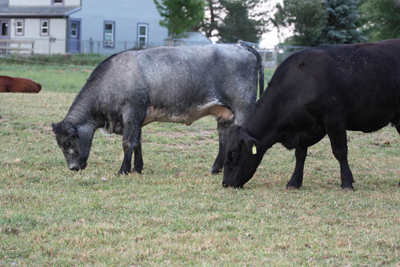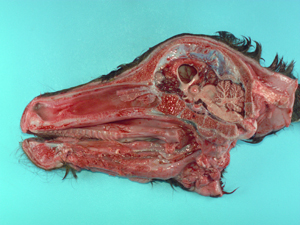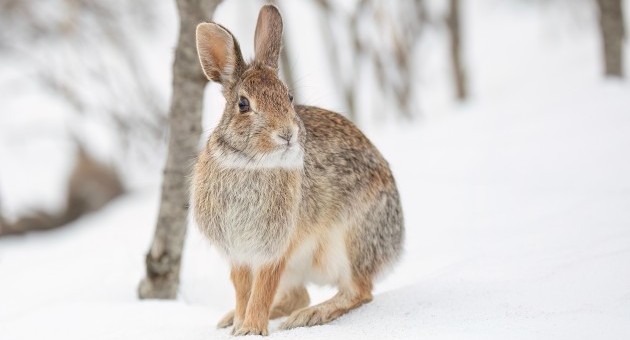It was a "U" year when Mango (of the Fruit Family) gave birth to a blue roan heifer calf. We named her "Ultramarine" and called her Blue. The blue roan color in cattle is usually the result of breeding a black cow (or bull) to a white bull (or cow) and results in a wide variety of blue coloration depending on the ratio of black to white hairs. To get a solid blue calf you want to mate a solid colored (not spotted) animals. Mango (a Kumquat daughter) was a homozygous black cow and the sire (father) was white. Although we talk about black being dominant and red recessive, color pattern in cattle, like dogs, is much more complicated, and of course there are breed influences, so when you start crossing breeds you can get some really wild colors and patterns.
 One of the most common breeds in the US is the Angus - they are black and polled, some are carriers of the recessive red gene. The Red Angus breed was developed 40 some years ago by a small group of cattle men and woman who had vision and foresight and realized that it was important to measure and record things. They basically obtained a group a red Angus cattle that the black Angus breeders didn't want because of color. I personally, like the Red Angus breed better than the black, but like each breed of dog, each breed of cattle offers something different.
One of the most common breeds in the US is the Angus - they are black and polled, some are carriers of the recessive red gene. The Red Angus breed was developed 40 some years ago by a small group of cattle men and woman who had vision and foresight and realized that it was important to measure and record things. They basically obtained a group a red Angus cattle that the black Angus breeders didn't want because of color. I personally, like the Red Angus breed better than the black, but like each breed of dog, each breed of cattle offers something different.
Hereford, Angus and Shorthorn breeds are considered "British" breeds while the Maine - Anjou, Charolais, Simmental, Chianina (among others) are considered "continental" breeds. The British breeds are well established and arrived in the US before 1900. Herefords a red white faced cattle. Shorthorns are multi patterned - red, white, and roan but not black and Aberdeen Angus were preferably black.
Although many of the "continental breeds" imported to the US and Canada is the 60s and 70s came in their original color, most have been influenced by the black Angus. The fullblood Maine-Anjou is a big, docile red and white and horned dual purpose (milk and meat) breed from France; the Chianina is a large white animal used in draft from Italy; Simmentals were large, rapidly growing red and white Swiss cattle; Charolais, also from France, were large, heavily muscled white cattle. Black is the preferred color in the US, so many of the continental breeds have infused the black color from Angus. Thus while many of the breed registries register cattle "by breed" just as many will register crossbred cattle. Of the major breeds, Angus and Hereford do not have crossbreeding registries.
But I digress - from the time she was a calf, Blue stood out in the pasture - you would notice her because in a herd of mostly solid colored cattle (red and black) she was unusual - people were shocked to see a blue cow. It was always with great anticipation that we awaited the birth of Blue's calves - what kind of funky color would they be? The roan pattern, common is Shorthorn cattle, is inherited as a heterozygous genotype. Roaning is basically the intermixing of two different colored hairs - black and white make a blue roan while red and white make a red roan. In cattle with spots the roan only shows up in the area where the solid color would be - thus getting a totally blue cow is relatively unusual.
This year, 2012, Blue was due on March 10th, but of course Mother Nature being who she is we always start checking cows before the due date. It had been a busy time, besides calving out cows our ancient Beagle was in kidney failure and because we had taught her to ask to go out, we were getting up very often in the night and felt pretty much sleep deprived. On a brisk February afternoon we were checking cows and it was clear Blue was going to calve in the very near future. It seemed if we took a 30 minute nap we could come back out to the barn and be available should the cow need some help - but she is a cow, not a heifer, and we expected the calf to be up and nursing when we returned in 30 minutes.
Well if you are tired and need to get up in half an hour you really need to set an alarm. Two and a half hours later we woke with a start and literally ran to the barn semi clothed for winter weather. And there, lying on the ground, completely cleaned off by her mother was a beautiful dead heifer calf. I was immediately immersed in a very heavy does of bovine guilt - if I had gotten up - if I had been there - if...
 Every calf that dies on my farm is necropsied (equivalent of a human autopsy) - I want to know, heck I need to know could I have done something different to change the outcome. Bovine guilt. I started looking at the calf - maybe there was a clue as to why she died or what I should or could have done to change the outcome. I looked at her eyes - they were not cloudy (suggesting that she had not been dead in utero) and there were no cataracts (sign of an infectious disease). Her gums were not pale (suggesting she did not die from lack of blood) and her teeth were fully erupted and not loose (suggesting she was full term). When I opened her mouth I was struck immediately by the abnormality of her upper palate - it was basically missing (cleft palate). There are various degrees of cleft palate, and while they may make nursing and eating difficult, alone cleft palate is not lethal, Cleft palate has been reported in different breeds of cattle, sometimes seen with skeletal abnormalities and related to a toxin and sometimes believed to be inherited. We had recently begun investigating a syndrome in Shorthorn cattle that was a combination of hydrocephalus (water on the brain) and cleft palate. Since Blue is a half blood Shorthorn (from the sire) and the sire of this calf was a Shorthorn it was imperative that we determine if she also had hydrocephalus. Sometimes hydrocephalus is very obvious - a big domed skull and you can feel the fluid where the skull bones are not together. Sometimes the head looks normal and the pressure of the fluid squishes the brain (internal hydrocephalus) - that was the case with Blue's calf. The brain was so compressed that it basically could not perform the basic functions - like telling the calf to breath - we know the calf didn't breath because the lungs did not float (air in the lungs makes them buoyant and they will float in water). We took samples from the calf and Blue as well as a straw of semen from the sire and sent them to our favorite cattle gene guru Dr Jon Beever who has identified most of the genetic mutations in cattle. Hydrocephalus was the cause of death in this calf and my bovine guilt was assuaged.
Every calf that dies on my farm is necropsied (equivalent of a human autopsy) - I want to know, heck I need to know could I have done something different to change the outcome. Bovine guilt. I started looking at the calf - maybe there was a clue as to why she died or what I should or could have done to change the outcome. I looked at her eyes - they were not cloudy (suggesting that she had not been dead in utero) and there were no cataracts (sign of an infectious disease). Her gums were not pale (suggesting she did not die from lack of blood) and her teeth were fully erupted and not loose (suggesting she was full term). When I opened her mouth I was struck immediately by the abnormality of her upper palate - it was basically missing (cleft palate). There are various degrees of cleft palate, and while they may make nursing and eating difficult, alone cleft palate is not lethal, Cleft palate has been reported in different breeds of cattle, sometimes seen with skeletal abnormalities and related to a toxin and sometimes believed to be inherited. We had recently begun investigating a syndrome in Shorthorn cattle that was a combination of hydrocephalus (water on the brain) and cleft palate. Since Blue is a half blood Shorthorn (from the sire) and the sire of this calf was a Shorthorn it was imperative that we determine if she also had hydrocephalus. Sometimes hydrocephalus is very obvious - a big domed skull and you can feel the fluid where the skull bones are not together. Sometimes the head looks normal and the pressure of the fluid squishes the brain (internal hydrocephalus) - that was the case with Blue's calf. The brain was so compressed that it basically could not perform the basic functions - like telling the calf to breath - we know the calf didn't breath because the lungs did not float (air in the lungs makes them buoyant and they will float in water). We took samples from the calf and Blue as well as a straw of semen from the sire and sent them to our favorite cattle gene guru Dr Jon Beever who has identified most of the genetic mutations in cattle. Hydrocephalus was the cause of death in this calf and my bovine guilt was assuaged.
There is an old farmer saying: "If you're gonna have livestock you're gonna have dead stock" and something like "but it doesn't mean you have to like it.”
 |
Like this article? Don’t forget to share, like or follow us |
 |
NAIA WEEKLY ROUNDUP
FEATURED & LATEST ARTICLES
GET THE NAIA WEEKLY ROUNDUP VIA EMAIL FOR FREE
Stay Connected with The NAIA: Sign Up for The Weekly Roundup
Join our FREE newsletter and community of animal advocates and receive The NAIA Weekly Roundup straight to your inbox. Stay in the loop with the latest news, events, and ways you can make a difference in the lives of animals. Sign up now to stay informed to create positive change!
Sign Up



 NAIA at CITES CoP20, Unexpected Animal Interest Alliances, and More!
NAIA at CITES CoP20, Unexpected Animal Interest Alliances, and More!
 Sanctuary Gets a Big Fine, Dogs Kill Dogsitter, and More…
Sanctuary Gets a Big Fine, Dogs Kill Dogsitter, and More…
 Weekly Roundup: Thanksgiving Week Edition
Weekly Roundup: Thanksgiving Week Edition
 NYCLASS Lawsuit, Penguin Retirement Homes, Beagle Noses, and More!
NYCLASS Lawsuit, Penguin Retirement Homes, Beagle Noses, and More!



